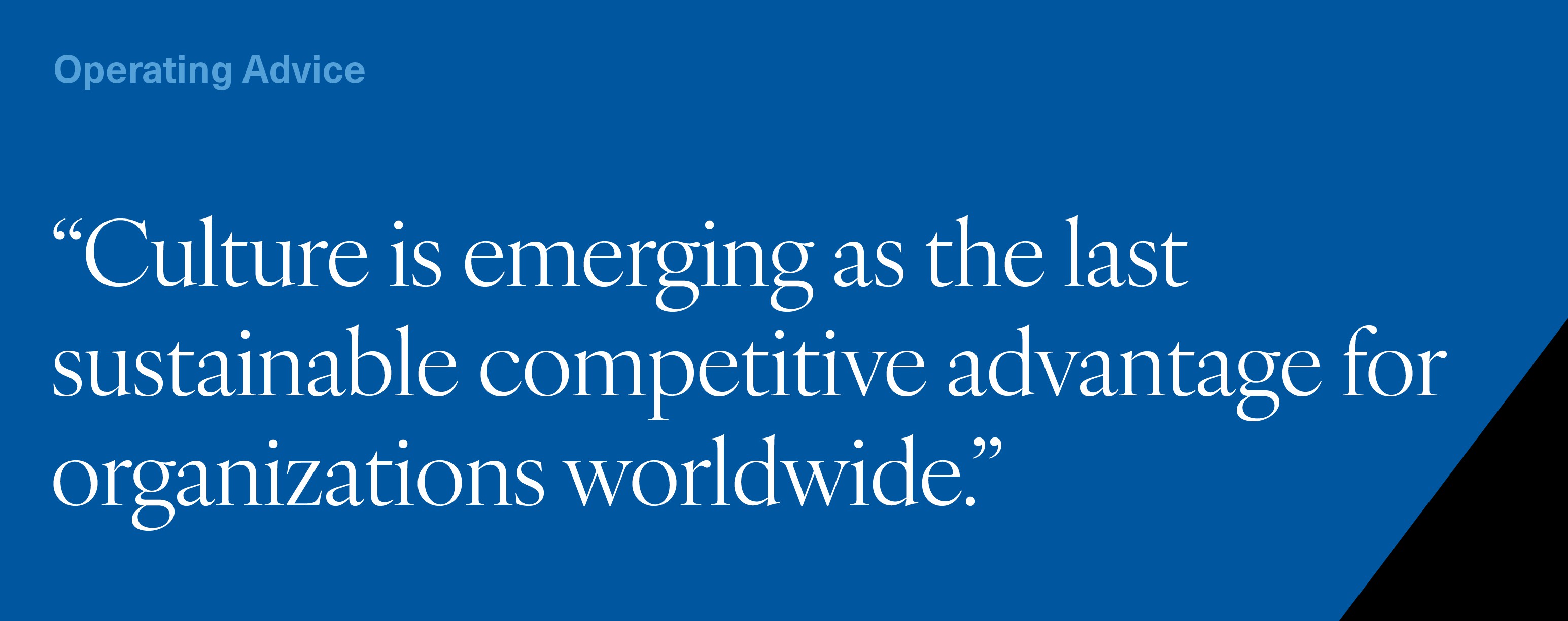The benefits of establishing a strong workplace culture are undeniable when it comes to growing a business.
Companies with strong workplace cultures benefit from greater retention, strong employee unity, better decision-making, and a more motivated workforce that translates into faster growth and financial success.
According to a recent study, 70% of business leaders see culture as a competitive advantage. Approximately 66% of c-suite executives and board members say culture is even more important than strategy or operations. Regardless of economic conditions, attracting and retaining talent will always remain a critical factor in facilitating growth and differentiating companies from competitors.
In our 20-plus years of growing mid-market companies, we’ve seen firsthand the many benefits of creating a solid culture. But building a workplace culture and getting every employee on board can present challenges. It requires a relentless focus on people, communication, and new ways of thinking.
How NewSpring Portfolio Companies Do It
Energage is a NewSpring portfolio company focused on helping organizations attract, recruit, and retain the right talent by enabling them to build, maintain, and brand their unique culture. Over the past 16 years, Energage has collected data from over 27 million employees across more than 70,000 organizations. This data powers Top Workplaces, the leading employer recognition program that has helped determine what drives business results and winning cultures. According to Energage CEO Eric Rubino, this data points to an overwhelmingly positive correlation between a high-quality culture and overall performance and growth.
“Culture is emerging as the last sustainable competitive advantage for organizations worldwide,” said Rubino. “Having an engaged workforce and being intentional about culture is critical to getting the right people in the right seats and keeping them there. As a company with the purpose of ‘making the world a better place to work together,’ Energage is committed to becoming an employer of choice while simultaneously helping its customers to do the same. We are proud to be part of creating work environments where employees feel genuinely appreciated for their efforts and see a long-term path for growth and fulfillment.”
Engaging Employees
The first step in building a high-performing, people-first workplace culture is to engage your employees with the organization’s overall business strategy. Involving employees in developing yearly plans, long-term strategies, and policies that affect their day-to-day operations will make them feel more connected to the company’s goals and excited about the work needed to get there.
Rubino said he consistently communicates high-level corporate plans and strategy across the leadership teams at his organization and solicits honest feedback on them. Once he has alignment on these goals and strategy, he delivers the plans to the entire organization, creating a sense of community and shared ownership of the company as a whole.
Alignment Across the Entire Organization
Andy Maner of NewSpring portfolio company Avantus Federal sees aligning culture with every employee across his organization as one of his primary responsibilities as CEO.
“It is my main job to make sure that the gap between desired culture and strategy is bridged with our investments of time and money,” Maner told us. “That could be communication, professional development, or simply a relentless approach to everything the company does and transmits. Whether it is how we compensate, celebrate, and collaborate or as small as how we talk to each other and how we motivate and engage our various communities, ending with how we act and present ourselves during the good times and the trying times – this is what I think about every single day.”
CEOs must live and breathe their company culture daily. Creating an enterprise-wide culture that lasts doesn’t happen after a half-day training session or one-off memo. It requires a steady drumbeat of reinforcement from the top down.
“First and foremost, I try and live the culture every minute of every day – to show that it is important and it matters … Financial performance is important – but attention to cultural priorities is nearly equal in our model,” Maner said.
“Our people are our greatest asset. And so, we ground our intentional culture in our day-to-day operations by making sure they are aligned and focused on our business strategy,” Rubino said. “This is crucial and achieved through thoughtful, ongoing, transparent communication. We understand the impact recruiting and retaining the right talent has on our bottom line and on the opportunities our employees have. When we bring the right people in the door and actively nurture our culture, we are more likely to have employees who are satisfied, engaged, and enthusiastic about driving our business forward.”
A Critical Driver of Growth
Culture is no longer an afterthought for growing companies — it has become a mission-critical driver of success. In a market where the competition for talent, attention, and new customers is at an all-time high, culture has never been more important in business than it is today.
For growing companies, culture often separates organizations from reaching new levels of growth or remaining in the lower end of the market. When every employee, from the CEO to the interns, is aligned on the company’s mission, values, and goals, companies can move faster, be more innovative, and encourage greater collaboration and teamwork.
